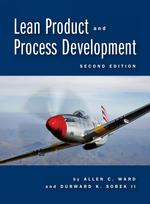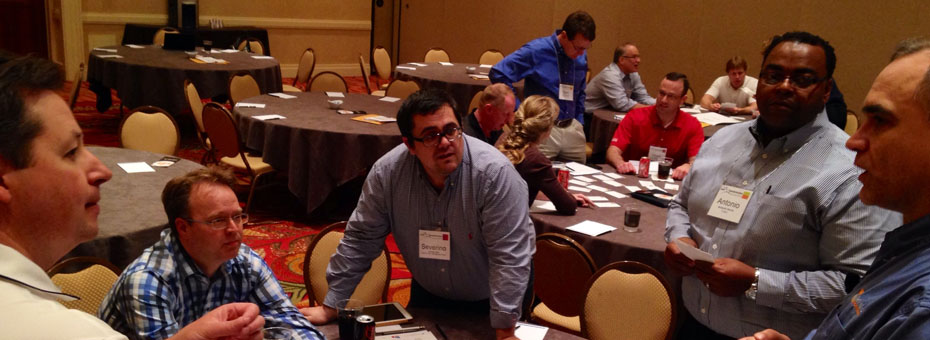Lean practitioners expect LEI’s Lean Transformation Summit to deliver lots of practical information to take back to work. But the 2014 event—with the theme “Improve the Work, Develop the People”—also provided plenty of inspiration, which is just as important.
 “Our business is one of a lot of diversity, a lot of problems. It was perfect for kaizen,” explained Margarette Purvis, CEO, Food Bank For New York City. In a plenary session, she explained how lean principles were helping it do more with fewer resources to serve clients.
“Our business is one of a lot of diversity, a lot of problems. It was perfect for kaizen,” explained Margarette Purvis, CEO, Food Bank For New York City. In a plenary session, she explained how lean principles were helping it do more with fewer resources to serve clients.
“Our mission is not to just end hunger, but to do it with dignity,” she said. “You don’t stand in that [food] line in the snow if you don’t have to.”
To meet a demand for one million meals annually, the nation’s largest food bank has put continuous improvement at the center of its strategy to develop efficient systems for delivering food with dignity by reducing the time people must stand in line waiting at a soup kitchen or pantry.
“Do they have to wait 1.5 hours in the snow to have a meal?” Purvis asked. She and Food Bank leaders know they can’t keep throwing people or money at such problems. “We can throw a system at it.”
In his keynote John Shook, Lean Enterprise Institute chairman and CEO, upheld the lofty theme of inspiration.
 “We want to change the world; we want to make it a better place,” Shook told the audience of 500-plus executives and managers. Although the goal is bold, lean thinkers pursue it with humility, said Shook, who defined lean management as a way to “systematically develop people and continuously improve processes to provide value and prosperity while consuming the fewest possible resources.”
“We want to change the world; we want to make it a better place,” Shook told the audience of 500-plus executives and managers. Although the goal is bold, lean thinkers pursue it with humility, said Shook, who defined lean management as a way to “systematically develop people and continuously improve processes to provide value and prosperity while consuming the fewest possible resources.”
Shook showed examples of lean transformations from several industries including startups, law enforcement, and the legal profession. Having started by addressing quality and productivity problems in repetitive manufacturing, lean is “going mainstream,” he said. And he shared a new model for guiding transformations. “We decided to expand on it and make it more complete. It’s not one-size-fits-all.”
This practical Lean Transformation Model encourages leaders to ask themselves and their team members five questions:
- What is our purpose; what business problem is the transformation trying to solve?
- How do we improve the actual work?
- How do we develop the people?
- What role must leadership take, and how does the management system support the new way of working?
- What basic thinking or assumptions underlie this transformation?
“If any of these dimensions are not addressed, the transformation will stumble eventually,” Shook said. “If you address these five questions consistently and persistently over time, you will make progress.”
In other plenary sessions, executives from a variety of businesses shared their experiences in leading lean transformations.
- Kevin Nolan, vice president-technology, GE Appliances, described how the unit went from the brink of being sold in 2008 to an onshoring success story by applying lean concepts in manufacturing. It then spread the principles, including lean startup practices, to product development. “If it weren’t for Lean, we wouldn’t be here talking to you,” he told the audience.
- William Owad, senior vice president of operational excellence, Cardinal Health, described development of a comprehensive program for developing internal lean leaders to create “sustainable change and capability” so Cardinal could keep pace with rapid changes in healthcare.
- Mike Lamach, CEO, Ingersoll Rand, said when the companybegan a lean transformation about four years ago, leadership began comparing the company’s performance on 11 business metrics to a group of 17 peers and competitors. As of the third quarter last year, the company had advanced at least one quartile in every one of the 11 metrics. Many measures had improved by two quartiles. “Employee engagement is the number one thing you need to improve metrics,” he said.
Lean Product and Process Development
 The Summit re-introduced the ideas in the recently published Lean Product and Process Development, second edition, by Allen Ward and Durward Sobek.
The Summit re-introduced the ideas in the recently published Lean Product and Process Development, second edition, by Allen Ward and Durward Sobek.
In a plenary presentation, “Lean Upstream Fastbreak,” Sobek and Jim Morgan, who used lean product development concepts while serving as a global engineering director at Ford Motor Company during its product-led revitalization, explained how lean product and process development differs from traditional development.
Traditional development generates ideas, focuses on the one idae considered best, then begins a cycle of analysis and iteration. However, the selected idea may be fundamentally flawed. In contrast, lean product development uses set-based concurrent engineering to consider sets of alternatives in order to grasp the global landscape of possible solutions.
“It’s an entirely different ways of thinking,” said Sobek.
Special Session with Jim Womack
LEI founder Jim Womack hosted a special “Lean Talks” session.
The TED Talks-style breakout was open to selected Summit attendees who did 10-minute presentations (with minimal slides) on the conference theme, “Improve the Work, Develop People.” Check out the first two of these talks we’ve released thus far, “Learning Proactive Versus Reactive Management” with lean practitioner Brenda Kenefick and “Problem Solving with ThoughtWorks” with Kevin Kriner, and stay tuned for more in the coming months. Womack is co-author of business book classics The Machine That Changed the World, Lean Thinking, and author most recently of Gemba Walks.
 Open Space
Open Space
During a unique “Open Space” session attendees rapidly self-organized and collaborated on 12 topics that they proposed, including: how to begin strategy deployment; applying lean concepts to knowledge work; how to involve senior leaders; and how to run an effective daily huddle with staff. At the end of the session, each group reported out what they had learned. Check it out here.




